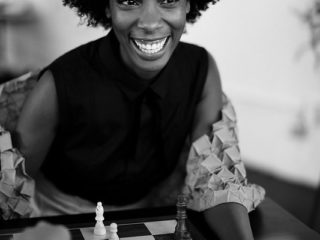Some people look at classic literature as those novels they will read, someday, while others reread a number of them over the years. I happen to use literature as a compass for my life. I have made a career out of my daydreams because of Marcel Proust, I like to read in the darkest corner of a library because of Jorge Luis Borges, and I want to move to Venice because of Thomas Mann’s dark and dreary portrayal of the place in his famous short story, Death in Venice.
More than just to say that we have read our Dickens and our Tolstoy, classic literary novels can teach us powerful lessons about how to live a well-lived life. At a time when how-to listicles and self-improvement articles are thriving, what better advice can we get to move forward, than from the voices of the past?
The following are five lessons to take with you this new year from the insightful writers whose words have only grown stronger with time.
Marcel Proust and The Rich Inner Life
In “In Search of Lost Time,” it takes a tiny petite madeleine dipped in tea for the world of Proust’s protagonist to creak open just enough to have him experience a memory he had long forgotten. After that, seven volumes ensue, detailing the protagonist’s rich inner life — from involuntary memories that bring back joy or terrible pain to the intricately detailed daydreams. This long novel shows that there is more to us than our daily habits and we all have the ability, if we choose, to cultivate a rich inner life that can lead us to dream big, be more creative and find that which makes us wander.
Daydreaming often gets a bad rep, especially in an age where being busy is a glorified status and yet, those who have a rich inner life are often the ones who thrive, as Victor Frankl noted in “Man’s Search for Meaning” when he was detailing the life of the people who spent time in concentration camps. Having a rich inner life is a choice and it starts by choosing not to fill all of your time with every form of distraction.
E.M. Forster and Kindness
“Kindness, more kindness, and even after that more kindness. I assure you it is the only hope” — this is the line that I always recall, whenever I think of Forster’s “A Passage to India.” Colliding cultures and racism, injustice and misunderstanding make this novel, but the point which underlies the whole story is the importance of kindness towards others, no matter their race, their culture or their religion. Kindness starts at home by being kind to yourself first, and then to those around you, but it should never stop there.

Ray Bradbury and The Slow Life
In “Fahrenheit 451” Bradbury writes about two women — the protagonist’s wife, Mildred Montag, who is one of the many people going “somewhere, somewhere, nowhere,” speeding in highways and always with the television loud enough to inhibit her from thinking, and Clarisse, the 17-year-old, who often looks up at the sky and plays with flowers. The latter risks coming across as a cliché, but as the story goes on with the book burning and the constant need of keeping people busy, Bradbury proves that Clarisse is the only one who is sure of how a well-lived life should look like.
The idea of slow living has been around for a few years now and the philosophy behind it is genuinely good, but how many of us are really leading a slow life? Are we simply portraying the idea of slow through our social media and nothing else?
Fyodor Dostoevsky and Our Mistakes
Our mistakes, our guilt, can often consume our every thought and lead us to isolate ourselves even more, rather than finding comfort in the help of others. Dostoevsky’s protagonist in “Crime and Punishment” commits murder and the all-consuming thoughts and nightmares he experiences are a worse punishment than prison. We can often find ourselves consumed by regrets, shame, guilt, where everything else seems to stop. While we cannot take our actions back, we can live a better life by choosing to redeem ourselves and seeking others to help us find our way back to a healthier state of mind.
Having a rich inner life is a choice and it starts by choosing not to fill all of your time with every form of distraction.
Virginia Woolf and Anxiety
There is a moment at the start of “Mrs. Dalloway” where Woolf’s protagonist, Clarissa, has this bad feeling that “something awful is about to happen.” Clarissa, with her flowers and her green dress and the parties she hosts, often comes across as being superficial, but what Woolf has done is to show us how one ordinary woman chooses to deal with her anxiety.
Clarissa has no outbursts. She isn’t dramatic in her behavior as is Gustave Flaubert’s protagonist in “Madame Bovary” when trying to fight off boredom, instead, she seems to float through the lives of those around her, enraging some and being unattainable to others, while dealing with the fears of World War I in the best way that she can — by going about her day, buying flowers and organizing a party, despite the sense of unease. Her composure, together with her inner dialogue, are an example of how we can deal with anxiety in our ordinary days, even when the world feels overwhelmingly scary.
There are more lessons, of course, not only in each of these books but in so many other literary novels. That’s the beauty of literature; no matter how much you read, you will never stop finding new ways to inspire you to lead the best life you could possibly live.
Which classic novels are your favorites?
Feature Image via Milena Mallory for Darling Issue No. 15











4 comments
I loved this post! Thank you for sharing your thoughts on these works, especially the Proust. I know some others have mentioned Jane Eyre and I am adding that as a stand-out for me, especially in terms of its context. “I have as much soul as you, – and full as much heart!” She then goes on to declare herself Rochester’s equal before God. Female empowerment from 1847.
Also, although it’s a bit outside the scope of classic literature, I will always have a soft spot for L.M. Montgomery’s incomparable Anne and her ability to find beauty and enchantment in everyday details – someone with a rich inner life who would appreciate the Proust.
Such a clever and unique topic, probably one of my favorite reads so far for Darling’s online blog, but probably because I’m a huge bookworm! I’ve just begun reading Jean Santeuil by Proust, which is considered to be a precursor to In Remembrance Of Things Past. I’m glad this serves as my introduction to Proust and look forward to reading his actual classic when the time comes. Your mention of Fahrenheit 451 makes me want to reread it all over again!
I don’t know if its considered a classic, But I LOVE Charlotte Bronte “Jane Eyre”, and Jane Austen’s “Pride and Prejudice”. I love a good love story with obstacles to overcome along the way
Hannah/ IG @theblessedlittlelife
http://www.recovering-hope.blogspot.com
Am feeling slightly ashamed I haven’t read any of these books. I often avoid classics but I need to up my reading game!
Charmaine Ng | Architecture & Lifestyle Blog
http://charmainenyw.com